Cosplayers at the Wizard World Comic Con in Portland (2017) share their thoughts about cosplay community and culture.
Month: May 2017
On Fumiyo Kouno
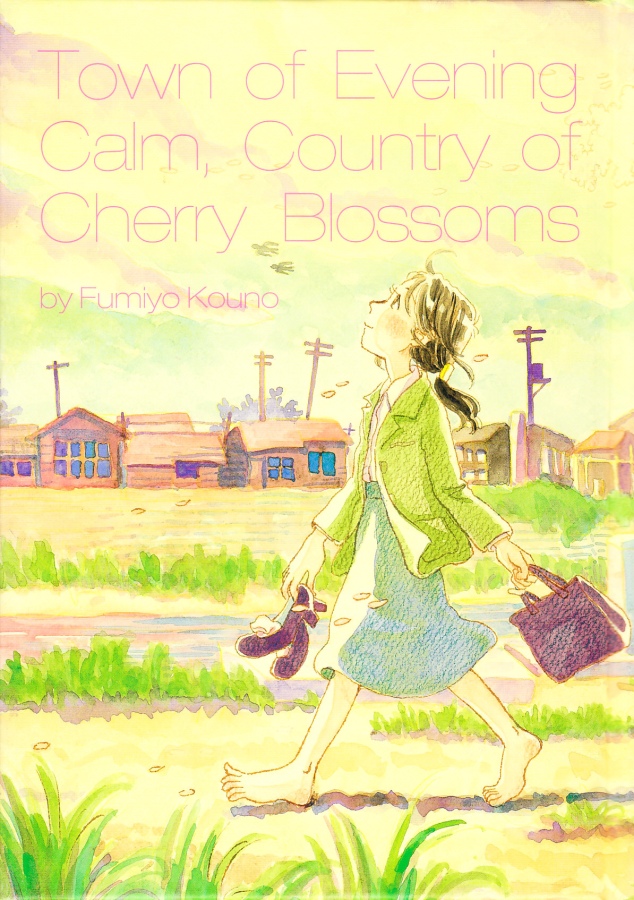
I was thinking some more on Saito Tamaki’s identification of the prevalence of beautiful fighting girls in manga and anime. To be fair, Tamaki doesn’t really look at it as an issue of what gets represented outside of Japan. And I’m not saying such representations aren’t popular in Japan, as they clearly are. I think I see it more like this: outside of the U.S., many people probably think of American comics as being about superheroes vis-a-vis the Marvel cinematic dominance (and the D.C. desire to become cinematically dominant). While this is mostly true in the sense of what’s broadly popular in the U.S., Americans also have direct marketplace access to other types of comics, which are non-superhero oriented and offer something different in their storytelling. The works of Robert Crumb and Chris Ware come to mind. Japanese artists of analogous import are likewise worth knowing, but maybe we may have to be willing to step outside of what’s popular to get to know them.
For example, continuing in the vein of my last blog post, how many outside of Japan are familiar with Fumiyo Kouno’s Town of Evening Calm, Country of Cherry Blossoms? Kouno’s manga is an astounding work that offers a multi-generational tale of atomic bomb survivors and their experiences with shame, guilt, love, gender, and sexuality. I’ll write more on it later, but if you don’t know it you should try to find a copy and sit down with it sometime. It’s has no beautiful fighting girls, but it is a thing of beauty.
Seeing Machiko Hasegawa

Looking at Machiko Hasegawa’s post-WWII yonkoma manga, Sazae-san, I’m drawn to two examples in particular. While others of her strips focus on family life and often offer gender observations, these strips seem to offer commentary on the Japanese-American dynamics and relationships after the war. In the above strip, Namihei, Sazae-san’s father, goes with an American colleague or friend to a photographer to have their portrait taken. However, when the photo is developed Masuo is all but left out of the frame. There seems to be a mixture of pride in the friendship or working relationship, perhaps exemplifying a certain post-war pride Japanese took in the developing post-war relationship, but the focus on the importance of the American here (and perhaps in the larger national scene itself) leaves the Japanese subject outside the picture. Likewise, while walking on a bridge below and enjoying the view, Sazae-san finds herself being beckoned by an American serviceman to pose for a photo. However, much to her embarrassment, it turns out that the photographer sees and was addressing not her but the geisha-looking woman behind her.
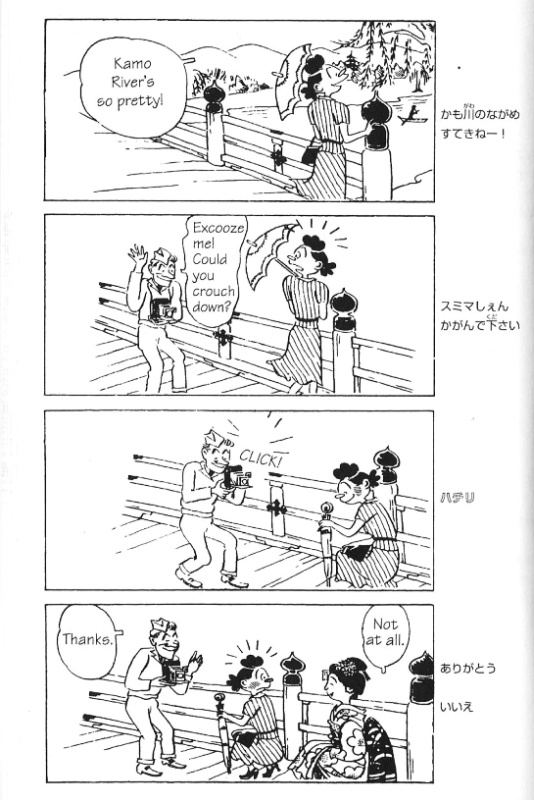
Sazae-san, even whilst between the American and the “geisha,” seems to remain unseen in the last frame. What is seen, instead, is the external stereotype and expectation formed by outsiders of what constitutes Japanese beauty, an idealized Japanese femininity. In the presence of the “geisha,” Sazae-san is an absence. I wonder to what extent the above yonkoma (four panel strip form of manga) can stand in as metaphors for Japan and manga/anime exports today. To what extent do manga and anime in the U.S. reflect an American focus, and to what extent do we miss seeing a wider range of what’s actually out there?
At the moment, I’m reading Beautiful Fighting Girl by Saito Tamaki and Japanese Visual Culture, edited by Mark W. MacWilliams. This makes me wonder to what degree does the beautiful fighting girl, so popular in manga and anime … from Princess Knight (1967) to Cutie Honey (1973) to Sylia/Priss/Linna of Bubblegum Crisis (1987) to Sailor Moon (1992) to Gally of Battle Angel (1993) to Birdy (1996) to Rushuna Tendo of Grenadier (2004) to almost the entire character list of Claymore (2007) to Saeko of Highschool of the Dead (2011) to Mikasa of Attack on Titan (2013) to name a few of the more memorable … to what extent do all these beautiful fighting girls and their popularity obscure or obfuscate what else is out there, not only in terms of the broader sense of Japanese femininity but even just within the range of representations of the feminine in manga and anime? As MacWilliams points out in his introduction to Japanese Visual Culture, manga and anime are part of mass art or mass culture and exist as industrial exports between capitalist economies; as such, artistic creation contends with or may be constrained by marketability.
Analogous to the photographer’s orientation with the “geisha” in Hasegawa’s yonkoma, to what extent do we in the U.S. primarily see manga and anime that fulfill our expectations? Just as the American serviceman above misses seeing Sazae-san for the “geisha” on the bridge, so too do many in the U.S. miss seeing Machiko Hasegawa for the beautiful fighting girls so pervasively in our midst. Consider how little known Machiko Hasegawa and her housewife heroine remain outside of Japan. It’s a shame, given that her manga, Sazae-san, ran for nearly thirty years, leading to radio and anime adaptations over the course of her career as an artist (the anime series is actually still active as of 2017). As well known as Charles Schulz is in the U.S., so Hasegawa is in Japan. She even has her own museum.
Back in the Straddle
I found Kevin McDonough’s review of Riverdale‘s season finale interesting given my time spent reading Bart Beaty’s Comics versus Art. McDonough seems to see comics straddling the line between art and immature entertainment:
As readers of this column may have concluded, I am not a big fan of comic book adaptations. For starters, there are simply too many of them. And, in full disclosure, I am no longer 12 years old. But to give the art form its due, comic books and graphic novels are often works of art, featuring stunning drawing and inventive graphic design, not to mention a vivid use of color, light and shadows. And, all too often, those elements are lost in movie and TV adaptations. In the end, comic books without their graphic power are a bit like music without sound. What’s the point?
Riverdale goes to some lengths to address this issue. The show has a distinctive color palette. It has rejected the sunny look of the original for a lurid tone as black as the roots of Archie’s red hair. Frequently compared to Twin Peaks, Riverdale often looks like another David Lynch creation–his 1986 big-screen melodrama sendup Blue Velvet.
While it’s true that McDonough tries to give comic books and graphic novels their due, acknowledging in general ways their “stunning drawing and inventive graphic design,” as well as their “vivid use of color, light and shadow,” he also dismisses them as juvenile via his perception of their intended audience (“I am no longer 12”). Even while praising Riverdale for addressing what’s often missing from comic book adaptations, he puts down comics in the same breath: the achievement only comes by way of the television show’s rejection of the “sunny look” of the original comic book source material (perhaps a kind of reverse Lichtenstein form of irony). Ultimately, for McDonough, Riverdale as a comic book adaptation finds its legitimacy via comparison with an identifiable great artist, auteur David Lynch.
I have to admit that without searching online I would have difficulty naming any graphic artist associated with the Archie line of comics, so the packaging and branding of the medium may well be contributory to the elision of the role of illustrators as artists, something Beaty examines via Disney’s relationship with Carl Barks and Marvel’s relationship with Jack Kirby, among others.
When are comic books and graphic novels art and when are they the source material for art? How has that line moved from Lichtenstein to today, and where is the line drawn today? Does having an underage audience exclude something by force from consideration of art? To what extent does mass consumption exclude something from consideration as art? What are the socio-cultural assumptions behind the need for identifiable great artists to recognize art objects? Some of these questions, of course, bring to mind John Berger’s Ways of Seeing and the mystification of art, so it would probably be worthwhile to study how the introduction of comics and graphic novels into the art world operates in relation to Berger’s analysis.
Comics versus Art
For Free Comic Book Day, I offer a review of Bart Beaty’s Comics versus Art, which is an excellent resource for anyone interested in the history of critical debates about the cultural place of comics.
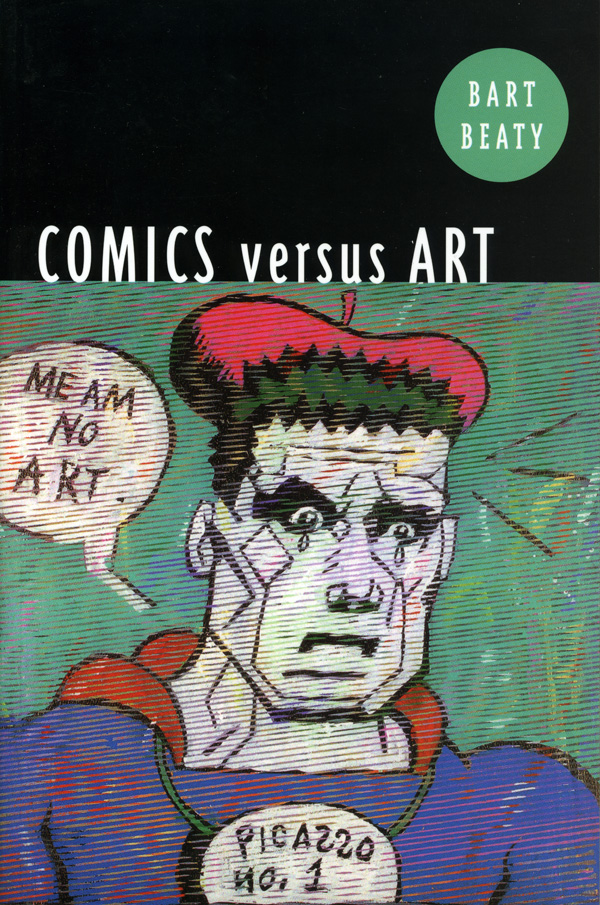
Beaty begins by observing how comics are often taught as literature and expresses a desire to consider them more from a graphic perspective as art. As he notes, “[o]ne of the significant consequences of the literary turn in the study of comics has been a tendency to drive attention away from comics as a form of visual culture” (18). His desire to examine comics in relation to art pushes back against historical assertions by Sterling North, David Carrier, Reinhold Reitberger, Wolfgang Fuchs, and others that comics are not art. Beaty quotes Karl E. Fortress, who even goes so far as to state that “[t]he comic strip artist is not concerned with art problems, problems of form, spatial relationships, and the expressive movement of line. In fact, a concern with such problems would, in all probability, incapacitate the comic strip artist as such” (19). Over the course of Comics versus Art, Beaty presents example after example that undermines Fortress’ low placement of comics. Beaty seems to root his framework for the exclusion of comics from art in the five symbolic handicaps that Thierry Groensteen believes contribute to the devaluation of comics as a cultural form, in short; 1. being a bastard genre, 2. being juvenile in form an audience, 3. being associated with degraded forms like caricature, 4. the non-integration of comics into the visual arts, and 5. their mass production and tiny form. The placement of mass culture within the high/low hierarchy of the art world plays a big role in Beaty’s project. He argues that the diminution and disparagement of mass culture and with it a feminization (or emasculation) of comics vis-a-vis the proper (and therefore more masculine) field of the high arts sets up a gendered framework through which the contentious relationship between comics and art can be best understood.
Beaty then examines a range of formal definitions of comics that have been proposed by Martin Sheridan (1942), Colton Waugh (1947), David Kunzle (1973), Will Eisner (1985), M. Thomas Inge (1990), Scott McCloud (1993), R.C. Harvey (1994), Paul Sassienie (1994), Bill Blackbeard (1995). While this mostly seems like an offset for his eventual argument that understanding comics as art cannot rely upon formal definitions of comics but instead on the consideration of whether a comics art world has developed to validate comics as art, the excursion proves more interesting than mere contrast material. For example, he compares the national interests of the likes of Blackbeard, who would like to foster national claims of comics being a particularly American genre beginning with The Yellow Kid, with the art history approach of the likes of Kunzle and Sassienie, who would have us date comics back to cave drawings and tapestry work (though perhaps really taking formal shape with Rodolphe Topffer). Toward the end of this excursion, he credits McCloud with the most well known formal definition of comics, but takes him to task for its limitations:
While his attention to formal properties has helped to reorient discussion of comics away from their strictly social functions, McCloud’s overly expansive conception of “art” (“any human activity which doesn’t grow out of either of our species’ two basic instincts: survival and reproduction”) serves to obscure the aesthetic element of comics by regarding almost all human activities as art. (35)
In part, I find Beaty’s dismissal of the formal definition of comics to be a somewhat artificial maneuver to set up his own project of examining whether a comics art world has developed to affirm comics as art. However, he does offer a strong historical overview of the attempts at formal definitions that in and of itself can be a useful resource for the projects of others, so if it is a straw man it is a substantially filled one.
When Beaty launches into his comics art world project directly in Chapter Three, he starts off with the Nietzsche’s concept of ressentiment, which “suggests that, among subordinated peoples, the ego creates the illusion of an enemy that can be blamed for one’s inferiority, the rationalization that one has been thwarted by ‘evil’ forces, and the eventual creation of an ‘imaginary vengeance'” (52). It is in this context that Beaty argues that the comics world resents the art world as best manifested by the resentment many comics artists seem to feel toward Roy Lichtenstein, who rose to pop art fame by extracting individual frames from actual comics, enlarging them, making them more colorful via his treatment of them, and receiving high art acclaim for the sense of irony that he brought to the surface. Via Lichtenstein, comics became the raw cultural material from which “real” art could be made. The manifested resentment can perhaps be best summed up by a wartime story by cartoonist Irv Novick that Steve Duin and Mike Richardson relate in Comics between the Panels, from which Beaty quotes:
He had one curious encounter at camp. He dropped by the chief of staff’s quarters one night and found a young soldier sitting on a bunk, crying like a baby. “He said he was an artist,” Novick remembered, “and he had to do menial work, like cleaning up the officers’ quarters.
“It turned out to be Roy Lichtenstein. The work he showed me was rather poor and academic.” Feeling sorry for the kid, Novick got on the horn and got him a better job. “Later on, one of the first things he started copying was my work. He didn’t come into his own, doing things that were worthwhile, until he started doing things that were less academic than that. He was just making large copies of the cartoons I had drawn and painting them. (56)
Beaty argues that Irv Novick, whose work only made its way into the art world via Lichtenstein’s “ironic” treatment, positions himself as the real man against Lichtenstein’s “crying like a baby” in order to try to reverse the way in which Lichtenstein’s fame and stature feminized comics and comic artists. He calls this a “crisis of masculinity” for comics posits that, contrary to claims by Andreas Huyssen that we’ve moved past the positioning of mass/commercial/popular culture as feminine and high culture as masculine, pop art’s relationship with comic books is one of gendered hierarchy: “It was clear, therefore, that Lichtenstein’s success stemmed, at least in part, from the association of his work with masculine–that is to say legitimated–values while his source material was held up as an example of the feminized traits in American (mass) culture that the artist had successfully recovered and repatriated.” (64). The irony that Lichtenstein’s work itself attempts to identify irony in traditional American gender roles is not lost on Beaty.
In ensuing chapters, Beaty looks for identifiable artists and masterpieces in the comics world. For example, in Chapter Four, after an interesting consideration of the public perception of the comics artist as represented in cinema via Artists and Models (1955) and How to Murder Your Wife (1965), he looks at the cases of Fletcher Hanks and Carl Barks, who could be identified as important cartoonists. While Beaty uses Hanks to pose the question of the thin distinction between naive art and comics art, his consideration of Barks is more expansive. Carl Barks was a Disney artist that the Disney studio did not credit but whose fans began to identify via his rendering of Donald Duck being distinct and better drawn than the rendering of other illustrators, enough so that the fans themselves eventually identified Barks as the artist. While not necessarily deeming Barks’ work to reach masterpiece status, Beaty holds this out as a turning point whereby a community of fans was able to recognize an artist and make his identity as an artist public. While Beaty spends much time discussing the role of fans in relation to the comics world and the development of a comics art world, I don’t think he ever fully resolves the implicit dichotomy of fans of comics versus patrons of the arts, itself a gendered component of his framework.
In the same chapter, he examines the artistic versus commercial battles of Jack “King” Kirby to own and possess his original works from Marvel, resulting in the return of just 1,900 out of 13,000 pieces for signing a waiver renouncing any claim to characters that he helped create. Beaty then considers in contrast the rise of Charles Schulz, who maintained full artistic and commercial licensing control over the Peanuts. What Beaty seems to find most interesting about Schulz is the way in which the comics world positions Schulz as perhaps the first great artist of the comics world. Nonetheless, the mantle seems to be an awkward one at best, for while The Complete Peanuts stands out as “a connoisseur’s product,” it seems “like an incongruous way to celibrate the work of a man who sold more than a million copies of a book titled Happiness Is a Warm Puppy” (95). Perhaps ironically, given his framework of the gender dichotomies surrounding high brow art and low brow or mass entertainment, Beaty never quite resolves within his own theorizing the mass-produced commercial aspect of comics that the art world itself seems to hold against the comics world.
In the remaining chapters, Beaty moves to identify comics masterpieces, the post-Lichtenstein debate of high versus low art in the formation of art objects and the role of collectibility (especially vis-a-vis Gary Panter) in the formation of a comics art world, and the place of comics in museum shows and exhibits. While George Herriman‘s Krazy Kat may be argued to be the first comics masterpiece and EC Comics may have offered masterpiece aesthetics, Beaty’s consideration of Robert Crumb and Art Spiegelman is especially worth calling out from the remainder of the book: “Comics Journal editor Gary Groth contrasted Spiegleman with Robert Crumb, citing the latter as a ‘landmark cartoonist,’ and the former as someone who has produced a ‘breakthrough work,’ which is to suggest that Spiegelman lacks Crumb’s natural drawing gifts but has, on the whole, produced a more significant piece upon which to hang his overall reputation” (117). In the context of Beaty’s gendered framework, Robert Crumb proves to be the defiant blue collar type man who rejects the high art world as corrupt at best and a big con at worst. As Crumb puts it, “I’m not interested in a bunch of cake eaters that go sniff around museums” (207). Meanwhile, Art Spiegelman via Maus proves to be the comics artist who achieves legitimation for himself and comics by producing what is arguably the first fully recognized masterpiece. This isn’t to say Crumb doesn’t have footing in high art, as his many showings in museums (documented by Beaty) would well attest to, but rather that Crumb even in finding acceptance rejects any need for validation, which for Beaty would be another form of ressentiment. Rather, via Spiegelman you can track a lineage from George Herriman’s Krazy Kat to Bernard Krigstein’s “Master Race” to Maus that may well elevate appreciation of the formal aesthetics of comics and what they’re capable of expressing in general. While Lichtenstein may have stood upon comics by highlighting their then perceived limitations, Spiegelman elevates them by showcasing their expressive capacity.
Perhaps also worth mentioning in Beaty’s project is Chapter Six, “Highbrow Comics and Lowbrow Art? The Shifiting Contexts of the Comics Art Object,” which examines the way in which the rise of publications like RAW and Blab! challenged the prejudices of kitsch and made comics into the low culture objects of choice for highbrows. For example, according to Beaty, RAW‘s selection of what to include or not to include in the way of comics art “allowed the editors to positon RAW within a particular comics lineage that was at once international, highly formalist, and, given the interests and reputation of mid-century cartoonists such as Wolverton, Rogers, and Hanks, irreverently outside the mainstream of American comics publishing” (135). Part of what RAW and Blab! did best was to create a space for comics art that sat alongside but separate from the central commercial models of publishing. Perhaps a shortcoming is that Beaty doesn’t really consider the gendering of this space given his larger framework.
In his final chapter, Beaty acknowledges that the book is difficult to conclude as the “legitimating process that comics are involved in remains very much ongoing” (212). However, in way of offering a conclusion he focuses on the work and place of Chris Ware, who serves as a significant and necessary bridge between the comics world and the high art world:
Insofar as he so perfectly occupies the space allotted to a cartoonist in the art world at this particular moment in time–innovatively cutting edge in formal terms, technically brilliant as a designer and draftsman, but viciously self deprecating in his willingness to occupy a diminished position in the field, strongly masculinist in his thematic concerns and aesthetic interests, and willfully ironic about the relationship between comics and art in a way that serves to mockingly reinforce, rather than challenge, existing power inequities–it can be said that if Chris Ware did not exist, the art world would have to invent him. (226)
I don’t know whether that last creative turn of phrase, suggesting that we’ve arrived at a point where the art world has need of the comics world and its artists, does enough to fulfill the promising theoretical framework with which Beaty sets out his project. And the insertion of “masculinist” there certainly feels more artificial than an organic part of his gendering critique. However, the sum of its parts (many of which I haven’t even touched on in this blog post, like the effect of attempting to censor comic books in the mid 20th Century) makes Comics versus Art well worth the read.
Tenshi no Tamago (Angel’s Egg)
I watched Tenshi no Tamago (Angel’s Egg) yesterday. It poses provocative philosophic and spiritual questions and seems fairly existentialist most of the time. Don’t expect a lot of dialogue or a lot of easy answers. Much, apparently, has been made of Mamoru Oshii’s own loss of faith prior to production, but I think leaning too heavily on that can produce an over-read, as can be found online.
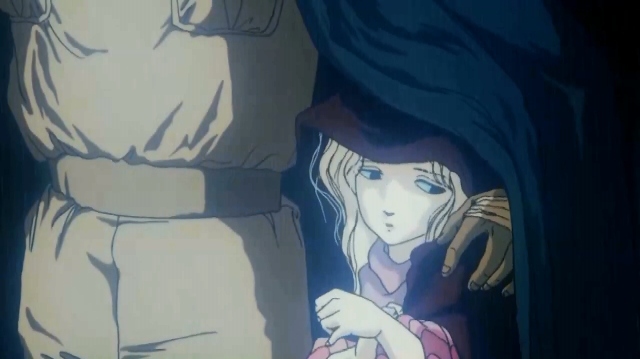
In quick summary, the plot revolves around a girl with an egg and a man with a weapon. Most of the point-of-view is from the girls perspective, but at the beginning and the end it is arguably from the man’s. The central tension seems to revolve around whether the man intends the girl or her interests regarding the egg any harm.
Two aesthetic features which stand out among many are: Oshii’s willingness to hold a shot for longer than most viewers would find comfortable and his lingering on mostly still moments with only one or two elements that suggest movement or time. Among the former, we have scenes where the girl looks at shadowy reflections in the water, a scene where the girl is waiting for a loud mechanized vehicle to approach and pass, a scene where the girl and the man walk in silhouette, and a scene where the man sits and the girl sleeps–the last is the longest of the held shots. I notice that anime in general seems more willing to use such technique than American animation. For example, I recently watched episode two of Gunslinger Girl, which many might consider fluff, and yet there’s a held shot early on in a car with a profile and the view passing by the window; it lasts for nearly twenty-five seconds with nothing else happening. In the case of Tenshi no Tamago‘s scene with the girl sleeping and the man sitting, the shot lasts almost two and a half minutes, with the only things moving most of the time being the fire and the girl (barely). The lingering quality combined with the limitation of movement to one or two things perhaps presages what we today call cinemagraphs, but here the effect is more than mere accent. In the case of the girl and the man walking in silhouette and the girl sleeping while the man sleeps, the visuals lay out better than any dialogue could the ambiguous and fraught tension that exists between the girl and the man. Our understanding of what’s transpiring pivots on the things that resolve from such shots.
Going back to Oshii’s loss of faith and a consideration of the story, there are definitely spiritual elements in Tenshi no Tamago, such as the cross-like weapon the man carries, a seemingly omnipotent eye/orb at the beginning and end, the recitation of the Noah’s Ark story, as well as the silhouetted appearance of an ark, and, of course, the young girl’s apparent faith in the life and eventual hatching of the egg. At the same time, I think there’s much more going on here than Oshii’s wrestling with Christianity. I’ll try to keep any spoilers vague, but the following probably contains some degree of story reveals, so you may want to watch the video linked in the anime’s title above before proceeding.
The girl exists in a dystopian world, seemingly post-apocalyptic, and she has with her a large egg. Initially, when she awakens, the egg is clearly presented as separate from her, though there’s enough ambiguity that one might wonder whether the egg came from her. Regardless, she places it under her dress, and draws it close to her body, such that it appears to be a part of her, a pregnancy. Her interests seem always to lie with the egg.
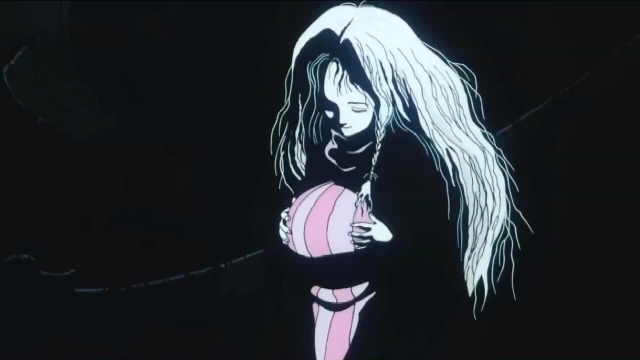
While I don’t think the man intends the girl or her interests any harm, his interests as manifested in curiosity about the egg and a need to know what is in it do eventually cause her and her interests harm. The man, unnamed and without memory, can perhaps be seen as an everyman who stands in for men who aspire to a Christ-like stature vis-a-vis his injured hands (see first image above) and his cross-like weapon (below).
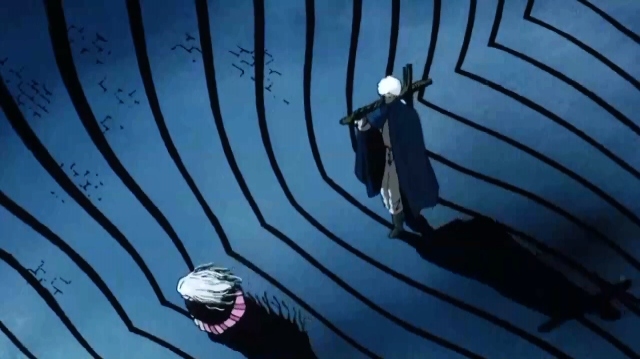
The man’s desire for concreteness or knowledge proves ultimately destructive, and if he is to be taken as an everyman it has larger implications. This isn’t to say that men are necessarily destructive, but perhaps that dominant forms of masculinity that know the world through manufactured symbols or probes or weapons tend to be far more destructive than creative. It probably does not bode well that the man initially arrives in the presence of the young girl by hopping off one of a series of phallic looking tanks being drawn by a tractor.
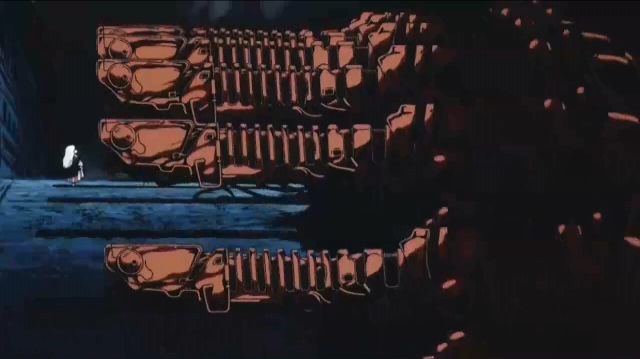
The association of men with destruction also lies in one of the most haunting sequences of Tenshi no Tamago, wherein men who otherwise seem dead or mere statues come fervently alive in the pursuit of gigantic shadowy fish that they can never catch. The shadowy fish swim through the streets of the city. The men’s obsessive pursuit (perhaps ala Moby Dick) results only in destruction to the city. The girl is wary of the presence of these men, whether static or in motion.
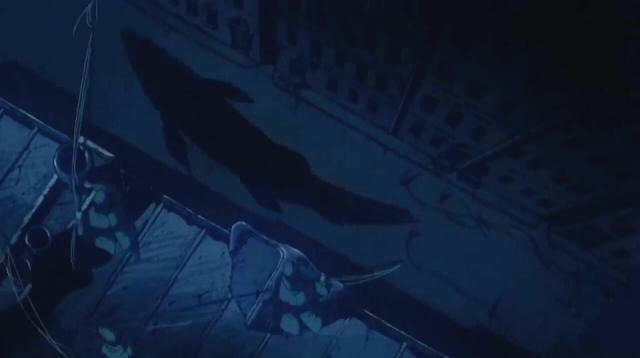
The girl herself is repeatedly associated with water. She gathers water, consumes it when the man rejects it, and seems to store it along passages and stairwells. Water arguably has associations with purity, femininity, and life. From a feminist perspective, it perhaps proves no surprise that when the girl first sees herself as a woman reflected in water it is after she experiences a grievous violation by the man, a violation that resolves the ongoing central tension.
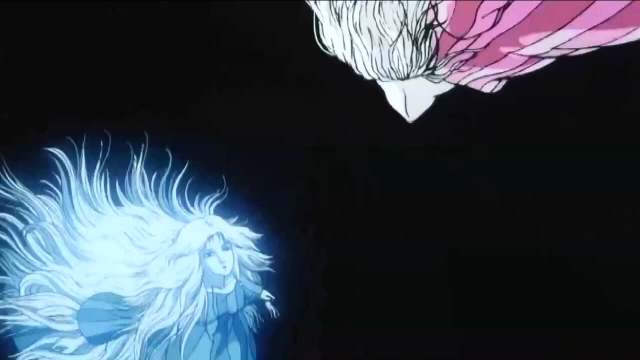
All the religious iconography in the anime is either dead, dying, in decay, or deathly static. There’s even the skeletal remains of some great bird that the girl hopes to replace from the egg; this great skeleton has a skull like a human head–so extinct angels, perhaps? The possible critiques of religion, of misplaced or misapplied faith are various, but undeniably any creative energies or life drive within the anime’s allegory reside with the girl/woman, and for this she is ultimately valorized like the Virgin Mary. Whether you see her final recuperation as affirming and hopeful or as hypocrisy and damning is surely open to interpretation and many shades of gray in between.
In any case, there are enough visual cues to suggest that the events of the anime have happened over and over, repeatedly and in the context of humanity being lost and/or trapped, which may suggest a Sisyphean quality to human efforts and perceived duties, gendered or otherwise.
